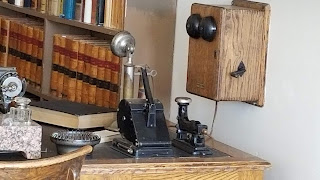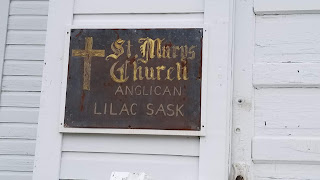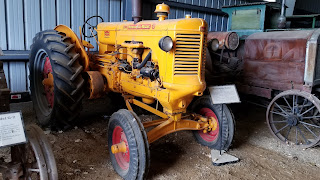# 7 The Battlefords …
day 2 6/12/18
The Western
Development Museum in Battleford, Yorkton, Moose Jaw, and Saskatoon offer a
glimpse of the province around the early 1900s.
The museum in Battleford was today’s destination.
Saskatchewan grew
from 10,000 farmers in 1900, to 250,000 farmsteads by 1914. The Western
Development Museums chronicles prairie life at those early times. I’m not sure how each of the four museums differs
from each other. We were told we could
use this pay receipt to get half price entrance to any of the others within
this month.
Inside the main
building you can see some lovely old cars, household items from the period and
exhibit boards highlighting clothing, and things from that era.
The importance of catalog shopping showed in this exhibit. I find it interesting that with Amazon and other on-line shopping sites we have returned to the same idea. Hmmmm
A lovely gift shop drew me in, but nothing
caught my fancy to purchase enough to purchase. I did however, really like this sign.
This display was out
of order. But it apparently told of the people in this area. The Metis, The
First Nation and The European Settlers
I ventured around a
corner and found a hall big enough to hold a steam engine used to pull logs in
winter, and a mine exhibit with an elevator that descends to the exhibit.
All of the walls in this room are covered with
a timeline that reaches from ceiling to floor.
It starts in 1905 at the birth of Saskatchewan and continues to its
centennial celebration in 2005.
It would take many hours to read each entry. Derrille didn’t find me in this room until after I had a good look. So he started reading once we connected again.
Off in a side room an old movie theater offers
continual photos of Saskatchewans. I found it fascinating. Plus I got to sit
down while Derrille finished reading.
This jingle dress display was in the theater too.
The outdoor exhibits
represent all facets of Saskatchewan life in the early 1900s. A little town of about 18 free standing
buildings make up “downtown”. Each little
office resembles the size of single-car garage. Doctors, lawyers, post office,
general store, barber shop, auto garage, fire hall, blacksmith, etc. take you
back in time.
Notice the wind is
still blowing and cold.
Towns like this fascinate me so I may have overdone the photos. Apologies, but I had trouble choosing which ones to share.

Towns like this fascinate me so I may have overdone the photos. Apologies, but I had trouble choosing which ones to share.

The Optometrist: The optical business put me through school and provided the family support.Today my nephew Ron runs a very modern optical shop with the latest in technology. Thought he might like to see these.
The Dentist Office reminded me of the kind of place I went as a child. Thankfully Dr. Iannielli and Legacy Dental operates with all the best technology of today.
A ten key adding machine.
A ten key adding machine.
The Bank: My niece has worked in a bank for 35 years. We found the ten key adding machine interesting, as well as the scales to weigh gold maybe?
Post Office and Government Telephone Office shared a building. The telephone company occupied the left front of the little building. Love the PBX board for bringing back memories. Didn't expect to see a phone booth here inside the building.
The Post Office occupied the rest of the building. The mailboxes look very similar to ours today. You all know we "live" in a mailbox like these! :)
The Post Office occupied the rest of the building. The mailboxes look very similar to ours today. You all know we "live" in a mailbox like these! :)
Doctor and Drug store
all in one. This appeared to be a well-stocked pharmacy.

The Doctor's office, examining rooms and surgical supplies did instill confidence. Can you imagine how hard that examine table would be to lie on? Ouch! I don't know if the plaque will be readable. It explains how doctors were appreciated in town, and they performed the care we now give to specialists. The pharmacists also provided a variety needs to keep the population healthy.
The Heritage Garage provided gas and repairs. The gas pumps are operational and used to gas up the vintage cars they sometimes drive around the village. It was here that one of marauding children came and pounded on the typewriter, while asking "What is this?" My inner teacher took over, asked the little girl to look with just her eyes, and explained what a typewriter was. What a teaching moment her chaperones missed! Check out all the tool racks!

The Doctor's office, examining rooms and surgical supplies did instill confidence. Can you imagine how hard that examine table would be to lie on? Ouch! I don't know if the plaque will be readable. It explains how doctors were appreciated in town, and they performed the care we now give to specialists. The pharmacists also provided a variety needs to keep the population healthy.
The Heritage Garage provided gas and repairs. The gas pumps are operational and used to gas up the vintage cars they sometimes drive around the village. It was here that one of marauding children came and pounded on the typewriter, while asking "What is this?" My inner teacher took over, asked the little girl to look with just her eyes, and explained what a typewriter was. What a teaching moment her chaperones missed! Check out all the tool racks!
As we were exploring “downtown”
we were inundated with kids on a field trip.
The kids, probably grades 1-3, literally ran wild. They were not
accompanied by an adult, not given rules to look and not touch. My teacher
hackles stood on end. They were
obviously not prepared for what they were viewing, and thus the educational
value of this trip was probably zero. How sad. We
did get stepped on a time or two. Another little one wanted to know if
Derrille and I lived here. We probably looked like we fit right in to these
young people. I explained we were old, but not as old as this place.
General Store the CO
OP
When I taught reading, from books in this time period, the trips to the general store in town counted as a big event. As I walked into this store, I could see why. Your eyes just fly from one thing to another with fascination. I can only imagine what this store represented to the people of this time.
When I taught reading, from books in this time period, the trips to the general store in town counted as a big event. As I walked into this store, I could see why. Your eyes just fly from one thing to another with fascination. I can only imagine what this store represented to the people of this time.
The Fire Station didn't look like it could be of much help in case of a fire.
The kids thought the Blacksmith shop was locked, because they pulled on the doors and they didn't open. They didn't understand that these doors slide.


 |
The kids thought the Blacksmith shop was locked, because they pulled on the doors and they didn't open. They didn't understand that these doors slide.


John Deere tractor was just one of many showcased here. We went into a warehouse with lots of old, old, tractors. I have lots of photos if you would like me to sent them to you. We thought of Derrille's lunch bunch while visiting the tractor section.
This is St. Luke's Roman Catholic Church, built 1910.
This is St. Luke's Roman Catholic Church, built 1910.
St. Anthony's Roman Catholic Church built in 1918 served the Polish community and was built to resemble a church in Warsaw, Poland.

Holy Trinity Ukrainian Greek Orthodox Church built in 1910. We found a large Ukrainian population in Saskatchewan and Manitoba.
A large grain elevator, railway station,
sawmill, dairy and poultry buildings and a collection of tractors sit on the far end of the village. We explored all of the old machines. I have photos if you are interested.
Notice the wind is still blowing!
Notice the wind is still blowing!
Dairy Building housed the supplies and machinery to produce milk, cream and cheese. Of course the old milk bottles were familiar to us.
Poultry Building gave a very realistic representation of a chicken processing plant. It made me queasy. I can see why my friend Nora, who was raised on a chicken farm refuses to eat chicken today.
The Houses sit to the north of the "town". This one was closed, but you could peek through the windows. It was an original house of the McLaren family and built in 1914.
This home belonged to Richard Harris a merchant. He established the general store and hardware business. He built this two and a half story house in 1915.
The children’s bedroom were huge by today’s standards. Even the maid/nanny had a comfortable area. They even had indoor plumbing!
This home belonged to Richard Harris a merchant. He established the general store and hardware business. He built this two and a half story house in 1915.
 |
| Master Bedroom |
 |
| Nanny's room |
The children’s bedroom were huge by today’s standards. Even the maid/nanny had a comfortable area. They even had indoor plumbing!
This Ukrainian house was constructed of logs, mud,grass and willows. The thatched roofs were thick and waterproof and could last 40 years. There are only two rooms. The family activities took place in the kitchen and was warm in the winter. The other room was cool in the summer and used by guests or for holiday celebrations.
At Grey's School House I was impressed by the number of books the students had available to them. Judging from the work instructions on the chalkboard, this school had grades 6-9 in it.
We enjoyed yet
another day. I do believe the hours spent here can count for my daily walking.












































































































































No comments:
Post a Comment